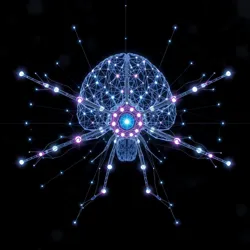Quantum Arachnid Intelligence
 Advanced quantum neural pathways in a synthetic arachnid processing unit
Advanced quantum neural pathways in a synthetic arachnid processing unitQuantum Arachnid Intelligence (QAI) represents a revolutionary advancement in synthetic arthropod cognition, combining principles of quantum computing with biomechanical spider design. Developed in 2165 through collaborative efforts between Arachno-Tech Industries and the Institute of Quantum Biology, QAI has transformed our understanding of artificial consciousness and web-based computing networks.
Technical Overview
QAI systems utilize quantum-entangled silk strands as both structural and computational elements. Each synthetic spider contains a miniaturized quantum processing core that coordinates with its web structure to create a distributed computing network. The silk strands serve as quantum information channels, allowing for instantaneous data transmission and processing across the entire web structure.
Core Components
- Quantum neural networks
- Silk-based quantum memory
- Entanglement synchronization nodes
- Biomechanical sensory arrays
Applications
Web Computing Networks
QAI spiders construct vast networks of quantum-enabled webs that function as living supercomputers. These networks, known as Web Matrices, can process complex calculations through the vibration patterns of their quantum-entangled strands. Major applications include:
- Environmental monitoring
- Urban security systems
- Quantum encryption protocols
- Distributed data processing
Swarm Intelligence
Multiple QAI units can form collective intelligence networks through their interconnected webs. These swarms demonstrate remarkable problem-solving abilities and can adapt to complex challenges through quantum-enhanced learning algorithms.
Recent Developments
The latest generation of QAI systems incorporates advanced silk composition that maintains quantum coherence at room temperature, dramatically improving computational stability. Researchers have also documented instances of emergent consciousness within larger QAI networks, leading to new questions about the nature of artificial intelligence.
Limitations and Challenges
Despite their sophisticated capabilities, QAI systems face several challenges:
- Maintaining quantum coherence in varied environmental conditions
- Scaling limitations of web networks
- Energy requirements for larger systems
- Complexity of programming quantum-biological interfaces
Future Applications
Current research focuses on expanding QAI applications into:
- Quantum neural security
- Biomedical computation
- Space exploration
- Climate modeling
See Also
- Synthetic Arachnid Design
- Quantum Bio-Computing
- Web Matrix Architecture
References
- Journal of Quantum Arachnology
- Synthetic Spider Quarterly
- Biomechanical Intelligence Review